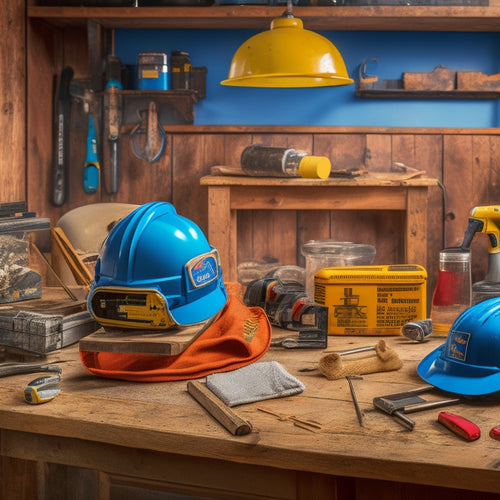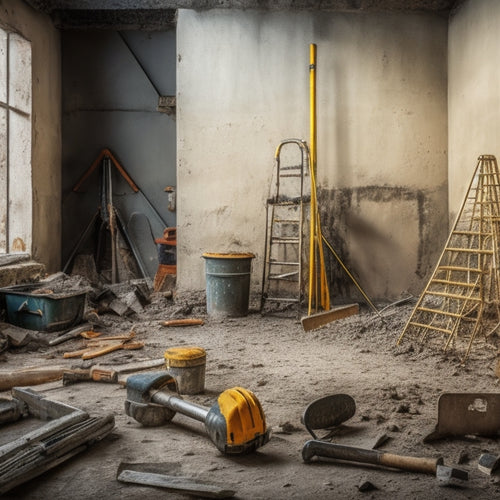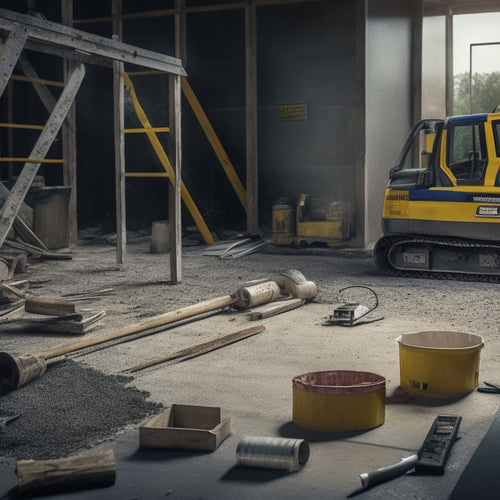
What to Expect in a Plaster Ceiling Renovation
Share
As you prepare for a plaster ceiling renovation, expect a complex process that requires meticulous planning and execution. You'll need to assess your ceiling's condition, checking for structural integrity, water damage, and surface irregularities. Next, you'll prepare for demolition by sealing off the area, disconnecting power, and gathering necessary tools. Removing old plasterwork involves scoring seams, containing the mess, and prying off the plaster. After that, you'll repair any ceiling damage, addressing leaks, cracks, and holes. Finally, you'll install new plasterwork, applying scratch coats, choosing the right plaster type, and working in small sections. From here, the intricacies of each step will come into focus.
Key Takeaways
• A thorough assessment of the ceiling's structural integrity and material type is crucial before renovation begins.
• Preparing the area by sealing it off, disconnecting power, and protecting air vents is essential for a safe and clean process.
• Removing old plasterwork requires scoring seams, wearing protective gear, and containing the mess with drop cloths or tarps.
• Repairing ceiling damage involves identifying and addressing hidden cracks, holes, and water damage before applying new plaster.
• Installing new plasterwork involves applying a scratch coat, choosing the right plaster type, and working in small sections for even coverage.
Assessing Ceiling Condition
Before starting a plaster ceiling renovation, you must carefully evaluate the ceiling's condition to identify potential issues that could impact the project's scope, timeline, and budget. This critical step helps you understand the ceiling's structural integrity and the type of ceiling materials used.
You'll want to check for signs of water damage, cracks, or sagging, which can indicate more extensive repairs. Examine the ceiling's surface for any irregularities, such as unevenness or delamination. This will help you determine if the plaster is still securely attached to the lath or if it's already started to detach.
Take note of any musty odors or stains, which could indicate hidden water damage or mold growth. You should also inspect the ceiling's framing and supports to confirm they're sturdy enough to handle the weight of new materials.
Preparing for Demolition
With a thorough understanding of your ceiling's condition, you can now begin preparing for demolition, a critical step that requires careful planning to assure a safe and efficient removal of the old plaster.
To facilitate a smooth process, it's crucial to take necessary safety precautions. Start by sealing off the area with plastic sheets or tarps to contain the mess and prevent dust and debris from spreading to other parts of your home. Next, disconnect the power supply to any lighting fixtures or ceiling fans, and cover any air vents or ducts to prevent dust from circulating.
In terms of tool selection, you'll need a range of equipment, including pry bars, hammers, and safety gear like gloves, goggles, and a dust mask. Consider renting a dumpster or large trash bins to dispose of the old plaster and debris.
Clear the room of any furniture or valuables, and cover the floors with drop cloths or old sheets to protect them from damage. By taking these steps, you'll be well-prepared for the demolition process and can focus on removing the old plaster safely and efficiently.
Removing Old Plasterwork
You'll begin removing old plasterwork by locating the seams where the plaster meets the lath, typically marked by a slight indentation or a faint line, and scoring them with a utility knife or a scraper to weaken the bond between the two. This step is vital in ensuring a clean and efficient removal process.
As you begin removing the plaster, be sure to take necessary safety precautions. Wear a dust mask and safety goggles to protect yourself from the fine particles and debris that will be released.
It's also essential to contain the mess by laying down drop cloths or tarps to protect your floors and furniture.
By following these steps and taking the necessary precautions, you'll be able to successfully remove the old plasterwork and move on to the next stage of your renovation project.
Tools Needed:
-
Utility knife or scraper: for scoring the seams
-
Putty knife or trowel: for prying the plaster off the lath
-
Dust mask and safety goggles: for protecting yourself from debris and dust
- Drop cloths or tarps: for containing the mess and protecting your floors
Repairing Ceiling Damage
After successfully removing the old plasterwork, inspect the ceiling for any cracks, holes, or water damage that may have been hidden beneath the plaster, and prioritize repairs to ascertain a stable surface for the new installation.
You'll want to identify the type of damage and its cause to determine the best course of action. For instance, if you notice water stains or discoloration, it's likely due to a leaky roof or pipe, which you'll need to address before proceeding.
Cracks, on the other hand, may be a sign of structural issues or settling, requiring more extensive repairs. When dealing with holes, you'll need to assess their size and location to determine the best repair method.
In some cases, you may need to replace entire sections of drywall or add support beams to ascertain the ceiling can support the weight of the new plaster.
Installing New Plasterwork
Now that your ceiling is repaired and ready, it's time to apply the first layer of plaster, known as the scratch coat, which provides a strong bond between the substrate and the subsequent layers of plaster.
You'll need to decide on the type of plaster to use, such as lime-based, gypsum-based, or cement-based. Each has its own benefits and drawbacks, so it's important to choose the right one for your project.
Here are some key things to keep in mind during the installation process:
-
Proper surface preparation is vital for a strong bond between the plaster and substrate.
-
Work in small sections to maintain even coverage and avoid uneven drying.
-
Use the correct installation techniques, such as applying the plaster in thin layers and using a level to guarantee straight lines.
- Allow each layer to dry completely before applying the next one to prevent delamination.
Frequently Asked Questions
Can I Live in the House During the Renovation Process?
Can you live in the house during the renovation process? It's possible, but you'll need to take into account the noise levels and dust management.
Renovations can be loud and messy, so you'll want to take measures to minimize disruptions.
If you're willing to adapt, you can stay put, but be prepared for temporary changes to your daily routine.
How Long Will the Renovation Process Typically Take?
You're likely wondering how long the renovation process will take.
The project duration depends on several factors, including the size of your ceiling, complexity of the job, and the number of professionals involved.
Generally, a plaster ceiling renovation timeline can range from a few days to several weeks.
On average, you can expect the process to take around 2-4 weeks, assuming a standard ceiling size and minimal complications.
Will I Need to Replace My Entire Ceiling or Just Damaged Areas?
Are you stuck with a ceiling that's crumbling like a fragile reputation? Fear not!
When it comes to deciding between replacing your entire ceiling or just the damaged areas, a thorough ceiling assessment is key. You'll need to evaluate the extent of the damage and explore repair options.
If the damage is limited, you might get away with targeted repairs. But if the damage is widespread, a full replacement might be the better choice.
Either way, you're in control - and that's a solid foundation for a successful renovation.
Are There Any Specific Building Codes I Need to Comply With?
When tackling a renovation, you'll need to comply with local regulations and safety standards.
It's essential to research and understand the specific building codes in your area. You'll want to guarantee that your plaster ceiling renovation meets the required standards for structural integrity, fire resistance, and accessibility.
Failing to comply can lead to costly rework, fines, or even safety hazards.
Take control of the process by familiarizing yourself with the relevant codes and regulations before starting the project.
Can I DIY Plaster Ceiling Renovation or Hire a Professional?
Carefully consider your ceiling conundrum: can you tackle the task yourself or should you seek a seasoned specialist?
When it comes to plaster ceiling renovation, DIY techniques can be tempting, but cost considerations are essential.
You'll need to weigh the worth of your time and skills against the potential risks and expenses of botched repairs.
Conclusion
As you emerge from the dust and debris of your plaster ceiling renovation, you'll be rewarded with a smooth, modern surface that's a far cry from the cracked and crumbling relic of yesteryear.
Your once-tired ceiling now shines like a Renaissance fresco, its beauty and integrity restored.
With each step of the process, from assessment to installation, you've navigated the complexities of plasterwork renovation like a master craftsman, and your handiwork will stand the test of time.
Related Posts
-

Top 3 Safety Essentials for DIY Renovations
When tackling a DIY renovation, you'll want to prioritize three essential safety items to protect yourself from poten...
-

What Tools to Rent for Block Wall Renovation
When renovating a block wall, it's vital to have the right tools for the job. You'll need demolition tools like pry b...
-

Home Renovation Safety Checklist for Homeowners
As a homeowner initiating a renovation project, you know that safety should be your top priority. Start by establishi...


